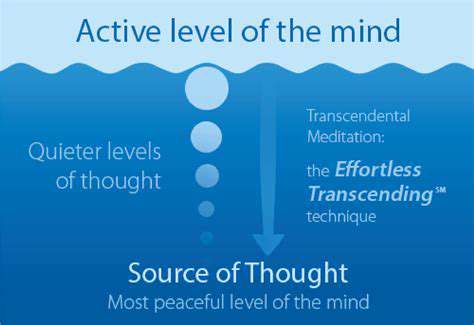Meditation Techniques for Anxiety Relaxation: Best Practices
Transcendental Meditation (TM): A Unique Approach to Inner Peace

Understanding the Core Principles of TM
Unlike many meditation forms that require focused concentration, Transcendental Meditation (TM) operates on a different principle. This technique uses personalized mantras - not as affirmations, but as vibrational tools to settle the mind. The brilliance of TM lies in its effortlessness - practitioners describe the experience as diving into deeper consciousness rather than climbing through focused effort. This natural approach makes it particularly effective for those who struggle with traditional concentration-based methods.
Scientific studies using EEG machines reveal distinct brainwave patterns during TM practice, showing increased coherence between different brain regions. This neural synchronization may explain why many report heightened creativity and problem-solving abilities alongside reduced anxiety. The technique doesn't seek to empty the mind, but rather to access its most settled, peaceful state - what practitioners call pure awareness.
The History and Development of TM
The story of TM begins with Maharishi Mahesh Yogi, who distilled ancient Vedic wisdom into a systematic practice suitable for modern life. Interestingly, the technique's global spread coincided with the 1960s cultural revolution, when Western celebrities like The Beatles brought it to mainstream attention. What began as an esoteric practice now boasts over ten million practitioners worldwide, supported by hundreds of research studies across fifty countries.
TM's evolution reflects an ongoing dialogue between tradition and science. While rooted in India's spiritual heritage, the organization actively collaborates with universities and research institutions to validate and refine the practice. This dual commitment to tradition and empirical validation has helped TM gain acceptance in diverse settings, from corporate boardrooms to veteran PTSD treatment programs.
The Practice of TM and Its Techniques
The TM initiation process feels more like receiving a personalized key than learning a generic technique. During a brief ceremony, a trained teacher provides a specific mantra selected based on various factors about the student. This customization makes each practitioner's experience unique, though the core mechanics remain consistent - silently repeating the mantra while sitting comfortably with eyes closed.
Contrary to popular belief, the mantra isn't meant to be analyzed or imbued with meaning. Its power comes from its vibrational quality and the mental set it creates. Many describe the experience as thoughts becoming less sticky, allowing awareness to settle into quieter states naturally. The recommended twenty-minute sessions, twice daily, create a rhythm that many practitioners find integrates seamlessly into daily life.
The Benefits of TM: Physical and Mental Well-being
The physiological effects of TM read like a wishlist for optimal health: reduced cortisol levels, lowered blood pressure, and even decreased biological age markers. Cardiologists particularly note its impact on hypertension, with some studies showing effects comparable to first-line medications. The American Heart Association has recognized TM as an effective adjunct therapy for heart health.
Mentally, regular practitioners report enhanced emotional stability and what psychologists call stress hardiness - the ability to face challenges without becoming overwhelmed. Corporate adopters cite measurable productivity increases and reduced burnout rates among employees. Perhaps most remarkably, group meditation studies suggest that when enough people practice together, measurable reductions in community violence and social stress indicators can occur.
TM and the Modern World: Adaptability and Applications
In our hyperconnected, always-on culture, TM offers a counterbalance that's both radical and practical. Its non-dogmatic approach makes it accessible to people of all faiths and none, while its standardized teaching preserves effectiveness across cultures. Busy professionals appreciate that it requires no special clothing, poses, or lifestyle changes - just a quiet corner and twenty minutes.
The technique has found surprising applications in high-stress environments. Some elite athletic teams use it for performance enhancement, while schools report improved focus and behavior in students. Even prisons have implemented TM programs with dramatic reductions in recidivism rates. As research continues to uncover new benefits, TM's role in modern wellness culture seems poised for continued growth.